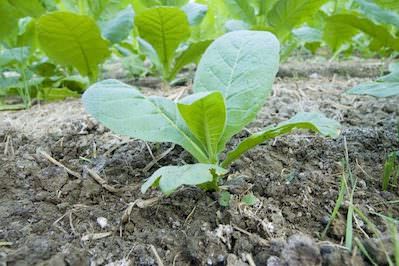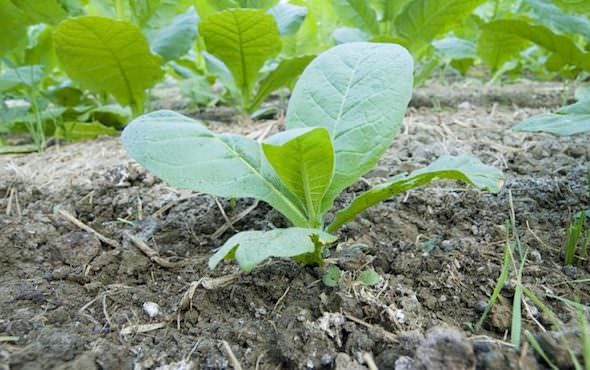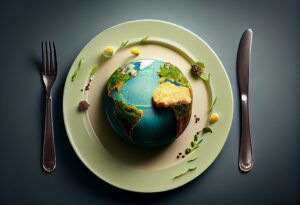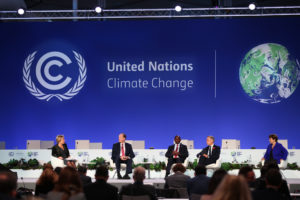Scientists Tinker With Plants to Boost Crop Yields and Carbon Storage
Modifying plants so they take in more carbon dioxide from the atmosphere offers hope of increasing crop yields and combating climate change.
By Tim Radford / Climate News Network

The experimental genetic modifications made to tobacco plants could potentially be applied to all staple food crops. (Andy Maluche via Flickr)
LONDON — Plant scientists in the US have devised a new way to enhance the efficiency of crops: tune up the biochemical machinery of plants such as wheat, rice, maize, or even cabbages, to make the best of the available light and so increase yields.
A second group of scientists believe they may even have gone one better than the vegetable world: they have explored plant chemistry and improved on it in order to get plants to trap more atmospheric carbon dioxide and turn it into tissue.
The first group have tested their genetic modifications only in Nicotiana, or tobacco plant — a standard experimental plant — but, in theory, what they have done could be applied to all the food staples. And the second group has yet to test its “carbon-fixing” improvements in any living organism. But both advances could be important in combating climate change, and in delivering more food for an increasingly demanding population.
Sunlight and shade
US researchers report in the journal Science that they started, not from the photosynthesis process, but from the mechanism exploited by plants to shield themselves from too much sunlight: this alters the leaf to dissipate the excess radiation as heat. The technical term is non-photochemical quenching: NPQ.
“But when a cloud crosses the sun, or a leaf goes into the shade of another, it can take up to half an hour for the NPQ process to relax. In the shade, the lack of light limits photosynthesis, and NPQ is also wasting light as heat,” said Stephen Long, a professor of plant biology and crop sciences at the University of Illinois at Urbana-Champaign.
Computer calculations showed that the process reduced crop productivity by 7.5% -30% per day, depending on the plant, and also the temperature. So the research team introduced three genes from Arabidopsis Thaliana, or thale cress, another laboratory favourite, to boost the tobacco plant’s existing gene package for photosynthesis.
“The United Nations predicts that by
2050 we’re going to need to produce
about 70% more food on the
land we’re currently using”
In field tests, of the three chosen modified seedling lines, two showed a 20% improvement in productivity, and yields from the third were 14% higher than from unmodified tobacco plants. The next step is to repeat the work in food species.
“We don’t know for certain this approach will work in other crops, but because we’re targeting a process that is the same in all crops, we’re pretty sure it will,” says Professor Long.
Meanwhile, in the same issue of Science, researchers from Germany report that they explored the cycle of enzymes used by plants to turn carbon dioxide from the air into plant proteins and other complex compounds. They then selected 17 enzymes from nine organisms and put them together to see if they could do the same or better in the laboratory.
They ended up with a new process nearly 20 times faster than nature achieves with green leaves and sunlight. Right now, it all happens in a test tube. The researchers are thinking in the long run of new ways to provide food for livestock, or new organic products for industry, and they have plans to take the laboratory study a lot further.
Artificial photosynthesis
“These could include the introduction of synthetic CO2-fixation cycles into organisms to bolster natural photosynthesis, or, say, in combination with photovoltaics, lead the way to artificial photosynthesis; this might, at the end, jumpstart the design of self-sustaining, completely synthetic carbon metabolism in bacterial and algal systems,” said Tobias Erb of the Max-Planck Institute at the University of Marburg.
Despite political resistance and both economic and ecological concern about the introduction of genetically modified crops in Europe and many other parts of the world, basic genetic research continues in universities everywhere, because it delivers a deeper understanding of why and how organisms do what they do.
And, as the carbon dioxide ratio in the atmosphere rises in ways that drive up the global temperature, while the human population increases at around 200,000 a day, crop breeders may need all the help they can get.
“The United Nations predicts that by 2050 we’re going to need to produce about 70% more food on the land we’re currently using,” says Professor Long. “My attitude is that it is very important to have these new technologies on the shelf now, because it can take 20 years before such inventions reach farmers’ fields. If we don’t do it now, we won’t have this solution when we need it.”
Tim Radford, a founding editor of Climate News Network, worked for The Guardian for 32 years, for most of that time as science editor. He has been covering climate change since 1988.
Your support matters…Independent journalism is under threat and overshadowed by heavily funded mainstream media.
You can help level the playing field. Become a member.
Your tax-deductible contribution keeps us digging beneath the headlines to give you thought-provoking, investigative reporting and analysis that unearths what's really happening- without compromise.
Give today to support our courageous, independent journalists.






You need to be a supporter to comment.
There are currently no responses to this article.
Be the first to respond.